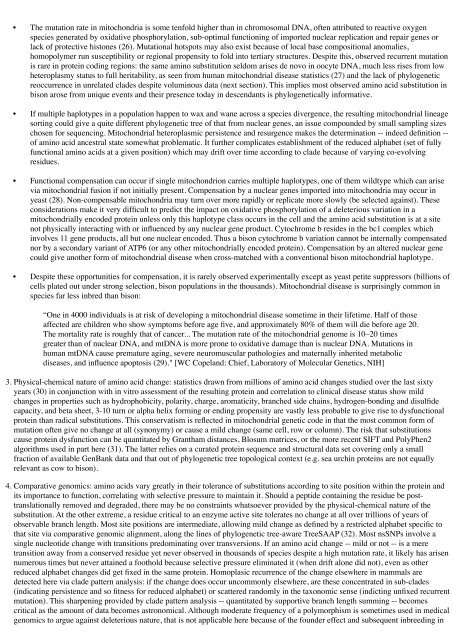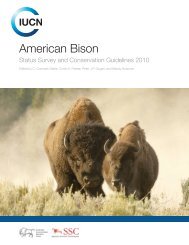Declaration Dr. Thomas H. Pringle - Buffalo Field Campaign
Declaration Dr. Thomas H. Pringle - Buffalo Field Campaign
Declaration Dr. Thomas H. Pringle - Buffalo Field Campaign
Create successful ePaper yourself
Turn your PDF publications into a flip-book with our unique Google optimized e-Paper software.
• The mutation rate in mitochondria is some tenfold higher than in chromosomal DNA, often attributed to reactive oxygen<br />
species generated by oxidative phosphorylation, sub-optimal functioning of imported nuclear replication and repair genes or<br />
lack of protective histones (26). Mutational hotspots may also exist because of local base compositional anomalies,<br />
homopolymer run susceptibility or regional propensity to fold into tertiary structures. Despite this, observed recurrent mutation<br />
is rare in protein coding regions: the same amino substitution seldom arises de novo in oocyte DNA, much less rises from low<br />
heteroplasmy status to full heritability, as seen from human mitochondrial disease statistics (27) and the lack of phylogenetic<br />
reoccurrence in unrelated clades despite voluminous data (next section). This implies most observed amino acid substitution in<br />
bison arose from unique events and their presence today in descendants is phylogenetically informative.<br />
• If multiple haplotypes in a population happen to wax and wane across a species divergence, the resulting mitochondrial lineage<br />
sorting could give a quite different phylogenetic tree of that from nuclear genes, an issue compounded by small sampling sizes<br />
chosen for sequencing. Mitochondrial heteroplasmic persistence and resurgence makes the determination -- indeed definition --<br />
of amino acid ancestral state somewhat problematic. It further complicates establishment of the reduced alphabet (set of fully<br />
functional amino acids at a given position) which may drift over time according to clade because of varying co-evolving<br />
residues.<br />
• Functional compensation can occur if single mitochondrion carries multiple haplotypes, one of them wildtype which can arise<br />
via mitochondrial fusion if not initially present. Compensation by a nuclear genes imported into mitochondria may occur in<br />
yeast (28). Non-compensable mitochondria may turn over more rapidly or replicate more slowly (be selected against). These<br />
considerations make it very difficult to predict the impact on oxidative phosphorylation of a deleterious variation in a<br />
mitochondrially encoded protein unless only this haplotype class occurs in the cell and the amino acid substitution is at a site<br />
not physically interacting with or influenced by any nuclear gene product. Cytochrome b resides in the bc1 complex which<br />
involves 11 gene products, all but one nuclear encoded. Thus a bison cytochrome b variation cannot be internally compensated<br />
nor by a secondary variant of ATP6 (or any other mitochondrially encoded protein). Compensation by an altered nuclear gene<br />
could give another form of mitochondrial disease when cross-matched with a conventional bison mitochondrial haplotype.<br />
• Despite these opportunities for compensation, it is rarely observed experimentally except as yeast petite suppressors (billions of<br />
cells plated out under strong selection, bison populations in the thousands). Mitochondrial disease is surprisingly common in<br />
species far less inbred than bison:<br />
“One in 4000 individuals is at risk of developing a mitochondrial disease sometime in their lifetime. Half of those<br />
affected are children who show symptoms before age five, and approximately 80% of them will die before age 20.<br />
The mortality rate is roughly that of cancer... The mutation rate of the mitochondrial genome is 10–20 times<br />
greater than of nuclear DNA, and mtDNA is more prone to oxidative damage than is nuclear DNA. Mutations in<br />
human mtDNA cause premature aging, severe neuromuscular pathologies and maternally inherited metabolic<br />
diseases, and influence apoptosis (29)." [WC Copeland: Chief, Laboratory of Molecular Genetics, NIH]<br />
3. Physical-chemical nature of amino acid change: statistics drawn from millions of amino acid changes studied over the last sixty<br />
years (30) in conjunction with in vitro assessment of the resulting protein and correlation to clinical disease status show mild<br />
changes in properties such as hydrophobicity, polarity, charge, aromaticity, branched side chains, hydrogen-bonding and disulfide<br />
capacity, and beta sheet, 3-10 turn or alpha helix forming or ending propensity are vastly less probable to give rise to dysfunctional<br />
protein than radical substitutions. This conservatism is reflected in mitochondrial genetic code in that the most common form of<br />
mutation often give no change at all (synonymy) or cause a mild change (same cell, row or column). The risk that substitutions<br />
cause protein dysfunction can be quantitated by Grantham distances, Blosum matrices, or the more recent SIFT and PolyPhen2<br />
algorithms used in part here (31). The latter relies on a curated protein sequence and structural data set covering only a small<br />
fraction of available GenBank data and that out of phylogenetic tree topological context (e.g. sea urchin proteins are not equally<br />
relevant as cow to bison).<br />
4. Comparative genomics: amino acids vary greatly in their tolerance of substitutions according to site position within the protein and<br />
its importance to function, correlating with selective pressure to maintain it. Should a peptide containing the residue be posttranslationally<br />
removed and degraded, there may be no constraints whatsoever provided by the physical-chemical nature of the<br />
substitution. At the other extreme, a residue critical to an enzyme active site tolerates no change at all over trillions of years of<br />
observable branch length. Most site positions are intermediate, allowing mild change as defined by a restricted alphabet specific to<br />
that site via comparative genomic alignment, along the lines of phylogenetic tree-aware TreeSAAP (32). Most nsSNPs involve a<br />
single nucleotide change with transitions predominating over transversions. If an amino acid change -- mild or not -- is a mere<br />
transition away from a conserved residue yet never observed in thousands of species despite a high mutation rate, it likely has arisen<br />
numerous times but never attained a foothold because selective pressure eliminated it (when drift alone did not), even as other<br />
reduced alphabet changes did get fixed in the same protein. Homoplasic recurrence of the change elsewhere in mammals are<br />
detected here via clade pattern analysis: if the change does occur uncommonly elsewhere, are these concentrated in sub-clades<br />
(indicating persistence and so fitness for reduced alphabet) or scattered randomly in the taxonomic sense (indicting unfixed recurrent<br />
mutation). This sharpening provided by clade pattern analysis -- quantitated by supportive branch length summing -- becomes<br />
critical as the amount of data becomes astronomical. Although moderate frequency of a polymorphism is sometimes used in medical<br />
genomics to argue against deleterious nature, that is not applicable here because of the founder effect and subsequent inbreeding in










